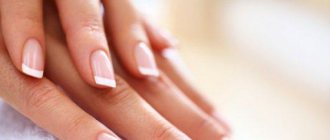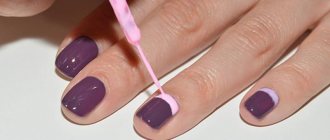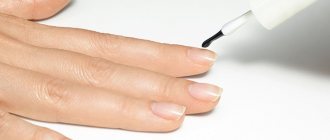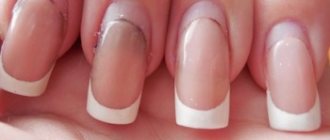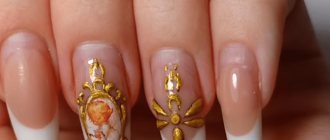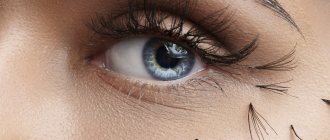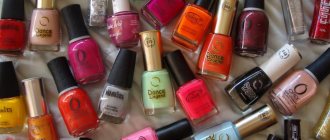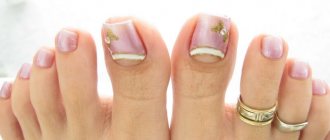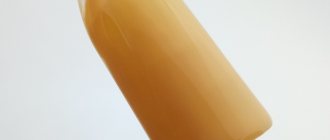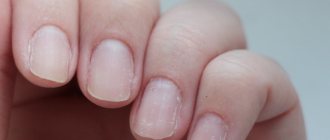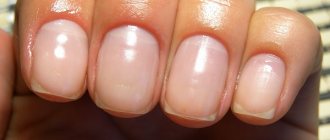Posted date: April 27, 2018
Many people are interested in whether it is possible to correct gel polish when the nail has grown out, because such a coating no longer looks aesthetically pleasing. The answer is yes, of course you can, but it doesn’t make much sense:
- Firstly, changing the entire coating is not much longer or more difficult,
- and secondly, an updated design or color always looks nicer and fresher.
But this does not mean that gel polish correction does not have the right to exist. On the contrary, now this is a very popular service. For example, if you don’t have a lot of time to update your manicure or if your nails grow very quickly, and the old coating on the grown part looks perfect and you really like it. Speaking of time, yes, correction saves about 20 minutes if you remove the coating by soaking, but if you use a hardware method for this (a cutter), then the removal time is almost equal to the time of preparing the old coating.
Nail correction with gel polish
When is it necessary to correct gel nails?
No matter how professional the master who applied gel polish on nails is, the client very soon has to visit him again. There may be several reasons for this, we will highlight the most important ones:
- The nail has grown. Ideally, correction of gel nails is done once every 3-4 weeks. Of course, the procedure can be postponed for a long time, because the drawing is beautiful or there is no time. But to be honest, these pens are becoming less and less beautiful every day. You can see the untreated nail plate, which at first girls can try to cover with regular polish. In addition, the longer the nail, the more likely it is to become a victim of chips or cracks.
- Physical pressure or blows. Gradually, girls get used to the new state of their nails and stop being careful with them. Sometimes it happens that the hand touches a hard object, or even worse, the client can get her finger pinched by the door. In any of these cases, the appearance of the nails deteriorates and correction of gel nails is necessary.
- Cracks. Inadequate quality of the applied gel polish or its incorrect application sometimes lead to the appearance of small or large cracks. The situation can also be corrected by correction, which becomes more complicated only if your own nail is also cracked.
- The coating is peeling off. The reasons may be the same as when cracks appear, but if this is not the first time, it is worth understanding the problem. Peeling manifests itself in the form of lifting of the coating on the sides and can reach one or one and a half millimeters.
Sometimes the problem of peeling occurs after treating nails with a worn-out file, which does not fully perform its function.
Types of correction
Based on the considered reasons that force the fair sex to visit a manicurist again and again, there are 3 main types of gel nail correction:
- mini-correction - most often it has to be done in the first week after applying the gel coating. The reason for this may be small cracks, chips or scratches that need to be removed and gel polish reapplied in their place;
- simple or medium - this can be a regular planned correction of gel nails, consisting of filing and varnishing the regrown part of the nail plate;
- complex or large - such a correction can be performed at any time, the cause may be serious damage to the coating (chips, large cracks, peeling, as well as nail breakage).
The latter type also includes correction of French gel nails, a more detailed description of the technique for performing which is given below.
Procedure
Let's move on to step-by-step instructions on how to do gel nail corrections at home.
Preparing the necessary materials
Any master who is going to make a correction must have special tools available:
- an antiseptic necessary to disinfect the skin around the nails and eliminate possible problems with fungus;
- the gel polish itself;
- primer, which is designed for a better gluing effect of the nail plate and gel;
- finishing coat, applied at the end of the procedure and makes the nails shiny;
- a product that removes the sticky layer after drying the nail in a UV lamp.
In addition to those already listed, it is also worth noting decorative elements - rhinestones, glitter, ribbons, etc. They are not mandatory during the correction process, but may be needed if you want to change the design on your nails.
Equipment preparation
The most important equipment during gel nail correction is an ultraviolet lamp. It is used for polymerization of gel polish, i.e. accelerating its hardening. In addition to the lamp, the manicurist will definitely need nail files, which he will use to polish the nail plate and give it shape.
If hardware correction of gel nails is carried out, you will need a special milling cutter. Depending on the expected result, various attachments are used, more details about which can be found in the table.
| Type of nozzles | Main purpose |
| Cylindrical with rounding | Works on the principle of a nail file for cutting off the upper part of the plate and polishing it (the rounded part is necessary for delicate processing of the area in the cuticle area) |
| Cylindrical without rounding | Used when processing the plate from the upper and lower sides, as well as to reduce the length of the nail |
| Cone-shaped | Perfectly suited at the junction of gel polish and regrown nails, as well as during the treatment of detached areas. More suitable for treating the inside of the nail |
Nail preparation
Correction of gel nails begins with preparing the surface to be corrected:
- to begin with, the hands are treated with an antiseptic;
- then the cuticle is pushed back to file the overgrown part with a natural nail file;
- Next, you need a file for extended nails, which is used to process the gel coating. In this case, the border between the real and artificial parts of the nail is made as less noticeable as possible, and existing detachments are removed;
- The last step in this stage is to form the free edge of the nail.
Gel polish coating
After the fingers have been properly prepared, the master removes all dust from them after filing. A stiff brush is used in this process. Now, to begin applying the gel coating, the specialist degreases the surface and applies primer to the regrown part. As soon as it dries, the gel is applied, and the hand is sent under the light of a UV lamp for half a minute. At the end of the time, there is no need to remove the sticky layer, and the nails are covered with modeling gel. Before this, if necessary, a design is made. Next, the pens are placed in the lamp again, for 3 minutes.
The modeling gel can be applied one more time, the free edge of the nail is sealed and returned to the lamp. This time the time is also 3 minutes.
Nail treatment
After re-polymerization, it is necessary to remove the sticky layer, for which lint-free wipes are excellent. The next step is to give the nail its final shape, and all dust is again removed with a brush. At this stage, you also need to disinfect, after which you can use a finishing gel to fix the result. After this, polymerization is also required - 1 minute.
If gel polish does get on the skin of your finger, an orange stick will come to the rescue and help you get rid of it carefully. At the end of the gel nail correction procedure, the master again removes the sticky layer and always applies moisturizing oil to the cuticle, which is gently rubbed into the skin.
Gel polish correction at home: what tools are needed
Correction of gel polish at home is performed using:
- manicure files with abrasiveness 100-180 and 240 grit;
- pusher and orange stick;
- scissors or cuticle nippers;
- remover;
- buff and brushes;
- degreaser and primer;
- base, gel polish of the desired shade and top;
- lamps for coating polymerization;
- lint-free wipes.
To paint the overgrown part of the nails, some people require a thin brush, but you can get by with the one that comes in the bottle. If your manicure is refreshed with the help of decorative elements (glitter, rhinestones, foil, etc.), you need to stock up on them too. After completing the procedure, it is useful to apply a little oil to the cuticle and rub.
French gel nail correction
How to correct gel nails if they have a French design applied on them? This can be done either manually or using hardware. In any case, this procedure is the most labor-intensive and, as a result, the most expensive. This is due to the need to maintain a smile, especially if the natural nail is visible under the gel.
Correction of French gel nails is done in this order:
- Disinfectant is used.
- All defective areas of the gel coating are removed, after which the dust is removed with a brush.
- Nails are degreased and covered with primer.
- Using a transparent modeling gel, the edge of the nail is raised, which must then be dried in a UV lamp and the sticky layer removed.
- The camouflage gel is used to form the area of the nails, which are polymerized again (2 minutes).
- Stress zones are crimped, secured with a clothespin, and the hands are again sent to dry (1 minute).
- After the sticky layer is removed, the edges and surface of the nails are processed with a nail file. Again, the dust is removed with a brush.
- This step is the most important - a smile is formed with white gel, after which polymerization is required for 4 minutes.
- Now the nails are given their final shape, after which unnecessary dust is removed, and the surface is degreased and coated with primer again.
- A fixing agent is applied (from the outside and inside) and polymerization is carried out for two minutes.
How often to correct gel polish
Correction should be done so often that the nails look neat, that is, every 2-4 weeks. It depends on the speed of their growth, it is different for everyone. If the hole is visible by 2-2.5 mm or completely, the overall appearance of the hands looks sloppy. And with strong growth of the free edge on which there is material, the architecture of the nails is disrupted. This area is overloaded, and there is a high risk of a crack or part of the plate breaking off.
If correction is needed precisely because of the formation of recent defects, it should be eliminated as soon as possible. Otherwise the problem may get worse. For example, a crack will extend beyond the free edge, and this is not only unsightly, but also painful.
Correction also includes caring for the cuticle and side ridges. If burrs, irregularities, or defects appear on them, you should get rid of them using scissors or a special file that grinds the skin. These problems can be avoided by regular use of emollient oil. When the cuticle grows, it is not necessary to cut off every millimeter. It is enough to regularly push it away with an orange stick.
If your nails grow quickly, so that you don’t have to correct them too often, you can cover them with shades of gel polish that are close to the natural color. Or use a camouflage base. You can put off the need for a design update if you do a manicure with negative space in the hole area.
